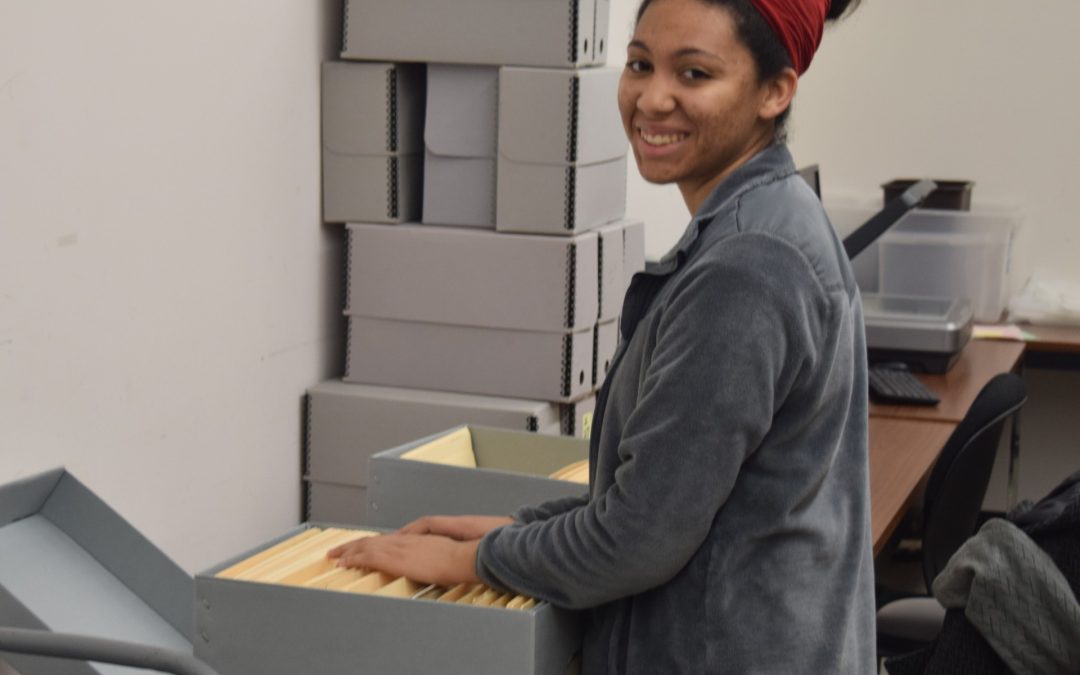
Ashley Cain, a highly valued student worker in Special Collections, currently assisting with processing of the James D. Bales Papers.
Every so often we feature a member of our staff or one of our outstanding student workers. Please meet Ashley Cain who has been a student work for Special Collections since 2014. Since then, Ashley has worked with multiple collections and gained experience with processing collections and exhibit design. Ashley is a Computer Science major planning to join the programming industry after graduation, possibly as a software or game developer.
How long have you worked in Special Collections? What areas of the department have been able to work in?
I have worked in Special Collections for about 2 and a half years. I started here fall semester of my freshman year. For the first year I worked with Cat Wallack in the Architectural Archives, and assisted in preparing some of the display cases around the library. Since then I’ve worked processing collections with Lilly Carrel and now Dr. Angela Fritz.
You just finished processing a collection, right? What can you tell us about the collection?
The collection that I just finished processing was the Dorothy D. Stuck Papers (MC 2088). Dorothy Stuck has led an extraordinary life. I couldn’t even begin to list all of the amazing things she has accomplished. The materials in this collection detail these accomplishments and tell her story. The collection includes material from Dorothy’s time as editor of one of the newspapers she and her husband owned. It also includes a lot of documents relating to her work in civil right and politics, and the positions she held such as Director for the Office of Civil rights in Dallas. She also co-wrote a book (which is in the collection) titled “Roberta: A Most Remarkable Fulbright” which is a biography about Senator J.W. Fulbright’s mother, Roberta Fulbright. It was very important to Dorothy and her co-author, Nan Snow, that people know that Roberta was an accomplished woman, and they didn’t want her to be overshadowed by her son’s accomplishments. And, now I know why the university has a dining hall named after her!
You’ve also been helping out with the James D. Bales project, correct? That’s a major grant-funded initiative the department has taken on to make the papers of the Harding University faculty member and conservative intellectual available to researchers.
I have mostly been alphabetizing and labeling folders so far. What I’ve learned from this (which isn’t surprising) is that Bales had notes/documentation on almost any subject you could think of!
What all is involved in processing a manuscript collection? Your most fascinating discovery?
Most of the collections I’ve worked on have been very small (some as small as a single item). One thing about processing collections that small is that you can become familiar with the individual items or documents much easier than with larger collections. But having less materials can also cause you to not be able to see the larger story that the materials belong to unless you already knew the historical background of those materials. With larger collections, like the Stuck papers, you are less familiar with the individual pieces, but the overall story is right in front of you.
What has been the most interesting project you’ve worked on? What have you learned?
One of the most interesting collections I’ve worked on was the Albert P. Stair Diary (MC 2059). It was interesting for two reasons. First, when I initially began processing it, it was labeled as belonging to John Stair (Albert’s brother). But, as I was reading the diary, I was lead to realize that it had been mislabeled. The second reason is because there were several pages where Albert Stair talked about how he became a prisoner of war during the Civil War, what his days looked like while her was there, and how he was traded back near the end of the war. Fascinating stuff!
Thanks, Ashley!
